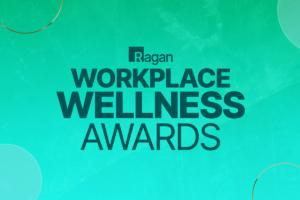How employers can help workers relieve financial burdens
Ragan Wellness caught up with Ron Ulrich of ADP Retirement Services to better understand how employers can help employees manage the financial stress associated with retirement.

A mixed race senior couple snuggle and flirt. They are camping and are seated in their tent. The door to their tent is unzipped. Light from the setting sun shines through the back of the tent. The couple is laughing. The husband has his eyes closed and is resting his forehead on his wife's temple. The wife is looking off into the distance while she laughs. The couple is dressed in casual clothing and the woman is wearing glasses.
Retirement. That’s a heavy (and oftentimes scary) word for many, regardless of age. Why would you think of retirement now if you were getting started in your career journey? How do you choose my level of risk in financial markets? How much can you even contribute to a retirement plan with my day-to-day living expenses? How much do youreally need to retire? And will you ever be able to? The subject poses a wealth of other questions … but you get the point.
Your individual financial literacy doesn’t require a MBA. In some instances, you should leave it to the experts for guidance.
Ragan Wellness caught up with one such expert, Ron Ulrich, vice president of product consulting and compliance at ADP Retirement Services, ahead of his session at Ragan’s Workplace Wellness Conference.
Ulrich highlights the company’s focus on employee experience for its 401(k) plan sponsors and plan participants, pointing to the ADP Achieve program that is designed to help employees “prepare for life’s financial challenges, improve financial literacy, and put them on the road to financial wellness.” The program uses a multi-touch, personalized experience to deliver individual financial benchmarks, relevant messaging and personalized guidance.

Ulrich speaks to putting employees on the path of financial wellness and even relieving employees of financial stress now.
This transcript has been edited for length and clarity.
Ragan Wellness: Any insights you can share as to some of the key trends in the wellbeing space…
Ron Ulrich: More and more employers are thinking of Emergency Savings Accounts (ESAs) as an important benefit to help address employee financial stress. These accounts have become an important tool for building an important savings buffer. Having funds available for emergency needs is one indicator of financial wellbeing. Now more than ever, employers understand that financial shocks can negatively impact an employee’s productivity. Offering benefits that help employees fortify their every day financial health can help reduce financial worries and improve employee engagement and complexity.
Congress has recognized the importance of helping Americans save for a more secure financial future. The Emergency Savings Act of 2022 would make ESAs an optional feature that can be added to a plan sponsor’s 401(k) plan. The legislation sets the maximum contribution amount at $2,500. Contributions would be on an after-tax basis, therefore, withdrawals from the account would be tax-penalty free.
RW: What are some of the best practices ADP recommends to clients as it relates to messaging around benefits?
Ulrich: The communications program should build individual profiles for employees using personal characteristics. Messaging should leverage data to personalize content. The communications program should draw on a variety of tools to drive engagement like calculators, videos, quizzes, interactive learning modules and more to deliver relevant content.
Metrics – from open rates and click-thru rates to actions taken and content engagement levels – should be set to measure campaign success. This data can help identify necessary refinements to improve the message and actions taken by the employee.
RW: How can or should companies be measuring success?
Ulrich: There are many different metrics for companies to consider when measuring the success of their retirement plans and financial wellness programs. A plan sponsor can use industry benchmarks to help determine their program goals for measurement.
It really starts with participation. If employees are not participating in the retirement plan or taking advantage of the financial wellness program, the first step is driving enrollment and engagement. Plan sponsors can work with their advisor and plan provider to establish enrollment programs to target employees who are eligible, but not participating. Typically, the more personalization of the message, the higher the engagement resulting in better campaign results. With strong plan participation, both the employee and the employer benefit. Employees start saving for their future and robust participation helps drive plan health.
A second metric to consider is contribution rates. Again, strong deferral rates strengthen the plan and help improve the retirement preparedness of the employee. A third metric is personalized rates of return. This metric will reflect the retirement readiness of the participant. Retirement readiness is an important score for measuring how financially prepared a participant is for retirement. All three of the metrics, participation, contribution rates and retirement readiness can help employers make sure their employees can securely transition to retirement.






